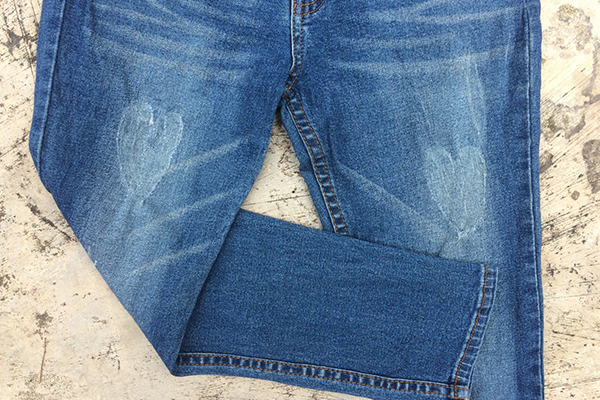
GOAL
I can make the J sound and the Y sound.
Jの音とYの音を発音できるようになる。

TRY IT!
A teenager in yellow pajamas yelled at John.

SOUNDS
Sound Profile
 Voicing音の有無
Voicing音の有無yes有声音
 Mouthくち
Mouthくちslightly openやや開ける
 Lips唇
Lips唇slightly pushed forwardやや前に突き出す
 Teeth 歯
Teeth 歯 Tongue舌
Tongue舌the tip of the tongue touching behind the top front teeth ➡ pulled back舌の先端を前歯の後ろに当てる➡引く
 Jaw顎
Jaw顎Steps
Slightly open your mouth and push your lips forward.ややくちを開けて唇を前に突き出しましょう。
Press the tip of your tongue behind your top front teeth.舌の先端を前歯の後ろに当てましょう。
Make a voiced sound. At the same time, pull your tongue back.音を出しましょう。同時に舌を後ろに引きましょう。

Katakana Otoshiana
When English words ending with the J sound are written in katakana, a vowel sound is added after them.
badge ➡ bajji (バッジ)
revenge ➡ ribenji (リベンジ)
image ➡ imeeji (イメージ)
Be careful not to add the vowel sound in English!
Jの音で終わる英単語がカタカナで発音される場合、単語の終わりに母音が追加されてしまいます。
badge ➡ bajji (バッジ)
revenge ➡ ribenji (リベンジ)
image ➡ imeeji (イメージ)
英語でJの音を発音する時は母音を追加しないように気を付けましょう!
 Voicing音の有無
Voicing音の有無yes有声音
 Mouthくち
Mouthくちslightly openやや開ける
 Lips唇
Lips唇 Teeth歯
Teeth歯 Tongue舌
Tongue舌the middle of the tongue close to but not touching the roof of the mouth ➡ dropped down舌の中央を上あごに触れない程度に近づける ➡ 下げる
 Jaw顎
Jaw顎Steps
Slightly open your mouth.ややくちを開けましょう。
Raise the middle of your tongue close to but not touching the roof of your mouth.舌の前方を前歯の後ろに触れない程度に近づけましょう。
Make a voiced sound. At the same time, drop your tongue down.音を出しましょう。同時に舌と顎を下げましょう。

Katakana Otoshiana
English words with the Y sound are written in katakana in many different ways.
yacht ➡ yotto (ヨット)
thank you ➡ sankyuu (サンキュー)
yes ➡ iesu (イエス)
yellow ➡ ieroo (イエロー)
However, in English, the Y sound is always formed the same way, regardless of the vowel that follows it.
Yの音が含まれる英単語はカタカナでいろいろな発音のされ方をします。
yacht ➡ yotto (ヨット)
thank you ➡ sankyuu (サンキュー)
yes ➡ iesu (イエス)
yellow ➡ ieroo (イエロー)
しかし、英語でYの音が発音される時は母音に関わらず発音の仕方は変わりません。
Steps
Slightly open your mouth and push your lips forward.ややくちを開けて唇を前に突き出しましょう。
Press the tip of your tongue behind your top front teeth.舌の先端を前歯の後ろに当てましょう。
Make a voiced sound. At the same time, pull your tongue back.音を出しましょう。同時に舌を後ろに引きましょう。
Steps
Slightly open your mouth.ややくちを開けましょう。
Raise the middle of your tongue close to but not touching the roof of your mouth.舌の前方を前歯の後ろに触れない程度に近づけましょう。
Make a voiced sound. At the same time, drop your tongue down.音を出しましょう。同時に舌と顎を下げましょう。

Katakana Otoshiana
When English words ending with the J sound are written in katakana, a vowel sound is added after them.
badge ➡ bajji (バッジ)
revenge ➡ ribenji (リベンジ)
image ➡ imeeji (イメージ)
Be careful not to add the vowel sound in English!
Jの音で終わる英単語がカタカナで発音される場合、単語の終わりに母音が追加されてしまいます。
badge ➡ bajji (バッジ)
revenge ➡ ribenji (リベンジ)
image ➡ imeeji (イメージ)
英語でJの音を発音する時は母音を追加しないように気を付けましょう!

Katakana Otoshiana
English words with the Y sound are written in katakana in many different ways.
yacht ➡ yotto (ヨット)
thank you ➡ sankyuu (サンキュー)
yes ➡ iesu (イエス)
yellow ➡ ieroo (イエロー)
However, in English, the Y sound is always formed the same way, regardless of the vowel that follows it.
Yの音が含まれる英単語はカタカナでいろいろな発音のされ方をします。
yacht ➡ yotto (ヨット)
thank you ➡ sankyuu (サンキュー)
yes ➡ iesu (イエス)
yellow ➡ ieroo (イエロー)
しかし、英語でYの音が発音される時は母音に関わらず発音の仕方は変わりません。

SENTENCES
/dʒ/
- John spilled juice on his jeans and jacket.
- Jerry saw an angel last July.
- Jed bought jam and some juice.
- Jeff was not a passenger on the jet.
- James told Jen a joke.
/j/
- Yanna likes yoga.
- The yellow yacht will sail to York.
- The young man yawned.
- Can I buy a yo-yo for 100 yen?
- Yes, you can eat yogurt for lunch.
/dʒ/ + /j/
- Jed is going to York in July.
- Yogurt with jam or jelly is yummy!
- James told the yacht club about the dangers of the sea.
- Yolanda paid ten thousand yen for the jet ski.
- A teenager in yellow pajamas yelled at John.

DIALOGUES
/dʒ/
| Student: | Jerry left his luggage on the train. |
| Tutor: | Oh, no! What does Jerry have in his luggage? |
| Student: | His school project and some clothes. His jacket, jeans, and pajamas. |
| Tutor: | I hope Jerry finds his luggage soon. It’s a little cold today. |
| Student: | Well, Jerry can wear my jacket for now. |
/j/
| Student: | Yay! Yanna and I are going to the US. |
| Tutor: | Oh, the US? Cool! When are you leaving? |
| Student: | Yeah, we’re going to visit Yanna’s dad in York. We’re leaving tomorrow. |
| Tutor: | Are you also going to visit her brother Yusef? |
| Student: | Yes, Yanna and I are going to see Yusef too! He lives near Yellowstone. |
/dʒ/ + /j/
| Student: | Hi. Can I join your yoga class? |
| Tutor: | Yes. You should talk to Jen. She’s the yoga teacher. |
| Student: | Is Jen the teenager in a yellow jacket and blue jeans? |
| Tutor: | Oh yes, that’s her! She looks young, but she just turned thirty in January last year. |
| Student: | Are you joking? She looks so young! I can’t believe she’s your age! |

TRY IT AGAIN!
A teenager in yellow pajamas yelled at John.

FEEDBACK
I can make the J sound and the Y sound.
Jの音とYの音を発音できるようになる。SCORING RUBRIC
|
4 |
3 |
2 |
1 |
|---|---|---|---|
|
You were able to produce today’s sounds very smoothly and naturally. Very well done! 本日の音を問題なく自然に発音できました。素晴らしいです。 |
You were able to produce today’s sounds with minimal difficulty. できました。上出来です。 |
You were able to produce today’s sounds but struggled a lot. We recommend taking 手こずりました。もう一度レッスンを 受けましょう。 |
You were unable to produce today’s sounds. Please take the もう一度レッスンを受けてください。 |
PERSONALIZED FEEDBACK
phonology
発音が相手にとって聞き取りやすいか phoneme
Is your pronunciation easy for the other person to hear?














